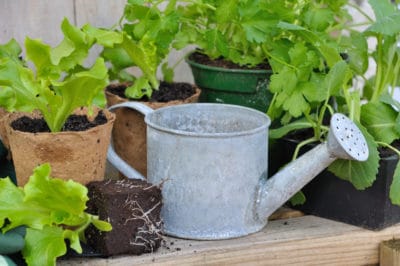Watering Regiment
It all depends on what the weather and your soil are like. During hot and dry spells, you may have to water plants twice a day if they are in well draining, sand-heavy soil. In clay soils, you may find that too much water will back up and create a sopping mess. Use your judgment as a guide. If the soil is dry or the plants appear wilted, they need to be watered.
Watering Options
There are several ways to get water to your lettuce crop:
- Drip Line
- Homemade Waterers
- Sprinklers
- Hand Watering
Drip Lines
One of the best ways to provide lettuce plants with the water they need is through a drip line. This system will conserve water, and because it doesn’t dump it all at once you avoid the risk of drowning your plants. It also works without you having to do much.
Homemade Waterers
During hot days, get a little extra water in the soil using homemade waterers. They can make a big difference in the health of your plants. Simply take a plastic bottle and puncture a small hole in the bottom that drips slowly. Fill it with water and stick into the soil next to your plant. It will slowly release the water over time keeping the plants moist.
Sprinklers
Sprinklers are handy but can be inefficient and even damaging if run inappropriately. Run sprinklers in the early mornings and evenings for best results. If they are run on a hot day, a lot of moisture is lost to evaporation. Another risk of running them on a sunny day is that too much water on the leaves under the sun causes burn and can ruin lettuce plants.
Hand Watering
While hand watering is the most labor intensive, it does allow you to observe what is happening in your garden and give each plant exactly what it needs. You are in full control and will most likely never over or under water.
Mulching
Adding mulch to the top of your soil drastically reduces the amount of water needed. It can be anything from straw to wood chips to grain hulls or leaves. A layer of mulch is like a blanket for the soil. Other benefits of mulching include additional nutrients trickling down through decaying organic matter, and bringing beneficial microorganisms and worms right up to the soil surface.
Risks of mulching include harboring slugs and bringing unwanted fungus into the garden. Just keep it a couple of inches away from touching the base of your plants and it will do more good than harm.
